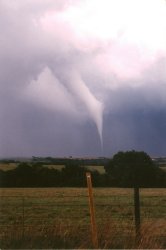 |
What is a tornado? A tornado is defined
as a violently rotating column of air that extends from the base of a cloud
to the ground or water. Not all tornadoes have a visible funnel extending
to the ground, although the circulation may be at ground level. Tornadoes
are rated on a scale known as the Fujuta or "F" scale from its creator,
Dr. Theordore Fujita from the University of Chicago. Wind speeds
in a tornado can be comparatively weak at less than 100 mph to devastating
at over 300 mph giving them their characteristic "freight train" or "jet
engine" sound.
Although tornadoes move in any direction, their
preferred vector of motion is from southwest to northeast at speeds of
30-40 mph. Again, there is the exception as tornadoes have been observed
to be nearly stationary to moving at speeds in excess of 70 mph.
Tornadoes also occur in every part of the country and can occur at any
time during the year. They cross lakes, rivers, and occur in mountains.
One tornado occurred in the Wyoming mountains at an elevation in excess
of 10,000 feet!
IT IS A DEADLY MYTH TO SAY, "TORNADOES CANNOT
OCCUR HERE BECAUSE...."
|

What to Do
TORNADO WATCH A tornado watch
is issued when conditions are favorable for the formation of tornadoes
in and close to the watch area. A watch does not mean that a tornado
has been sighted. It means to monitor the weather closely in case
of a warning. Check and review your plan of action should a warning
be issued for your immediate area. A tornado watch box is large rectangular
area that covers hundreds or perhaps a few thousand square miles.
Watches are issued by the Storms Prediction Center in Norman, Oklahoma.
TORNADO WARNING A tornado warning
means that a tornado has been sighted, indicated by Doppler radar, or conditions
favor tornado formation at any moment. Warnings are issued by local
National Weather Service offices and usually cover a few parishes or counties
at a time. If a tornado warning is issued for your local area, take
action immediately!
AT HOME:
1. Move immediately to a small interior
room or hallway of the lowest floor and cover yourself with a blanket or
mattress if possible. Contrary to popular belief - DO NOT
OPEN WINDOWS!
2. If an underground shelter is available,
go there immediately. In the deep south, the water table frequently
prevents storm shelters from existing.
MOBILE HOMES:
1. GET OUT! Move to a more sturdy
form of shelter. Unfortunately, tornadoes can strike with little
or no warning giving the occupants little time to react. If you are
in a mobile home with a tornado in progress, take the same precautions
as if you were in a frame home.
SCHOOLS:
1. Follow the school's plan of action
for tornadoes. In many cases, this action involves lining the edge
of the hallways on your knees with your head against the wall and your
hands covering the head.
2. Do NOT take shelter under large spanned
roofs such as in a gym or auditorium. The roofs will likely collapse.
3. As with the homes, do NOT open windows.
CARS:
1. Cars, like mobile homes, provide
little or no shelter from tornadoes. Many people try to outrun the
storm in their automobiles only to be trapped in traffic. Remember
that many roads are curved, whereas the tornado will likely take the straight
path.
2. Abandon automobiles for safe shelter.
Lie flat in a ditch or ravine - be cautious of flood waters.
3. Some people have taken shelter under
overpasses. People have been killed after taking shelter there.
However, as a last resort....
OUT OF DOORS:
1. As with the case of automobilies,
take shelter in the nearest ditch or low-lying ravine. Again, keep
in mind that heavy rains have likely occurred prior to the tornado producing
rapid water run-off. |

